
Architectural Styles and Revivals: The Second Empire Style
(written by Dr. Les Crocker, UWL Emeritus Professor of Art History)
Based on the grand public buildings in Paris designed for Napoleon III, the Second Empire style worked best on large structures where its layers of decoration could be shown off. The features that define this style are the mansard roof with dormer windows, and decorative brackets. The mansard roof is a steeply angled section that finished in an almost flat roof or as a convex shape. In Paris where the building heights were defined by law, this allowed almost another full story beneath the shingles and provided more apartments. This style could also feature columns, paired columns, half columns, triangular pediments, curved pediments, decorative window crests; the more complex, the better.
The most distinctive building in the United States in the Second Empire Style is the old State, War and Navy building in Washington D.C., under construction from 1871-1888 and was the largest office building in the world until construction of the Pentagon. It was disliked by many, but presidents and politicians are not noted for their understanding of The Arts.

The Eisenhower Executive Building in Washington D.C., originally called the State, War, and Navy Building. 2021 photo by author.
The Second Empire was not a style that could be easily reduced in size, but it was still used here and there on homes and buildings. In La Crosse, it is evident mostly in the use of the mansard roof and dormer windows. Architect William Nichols especially liked it for tower tops and hooded windows. Even though few examples of either remain, La Crosse had more Second Empire designs than most Midwestern communities. Recent restoration projects have helped to make these examples evident once again.
Public Buildings
First City Hall and Fire Station, Main Street, 1869
The most distinctive mansard roof was on, of all things, the first City Hall and Fire Station designed by W. H. J. Nichols and built in 1869. It is the first use of a mansard roof in La Crosse and probably the most elegant. The building beneath it was based on Michelangelo’s senate buildings on the Capitoline Hill in Rome, an extremely sophisticated source for a Midwestern small town, but Nichols was an extraordinary designer and seems to have liked the mansard roof since it appears on many of his designs
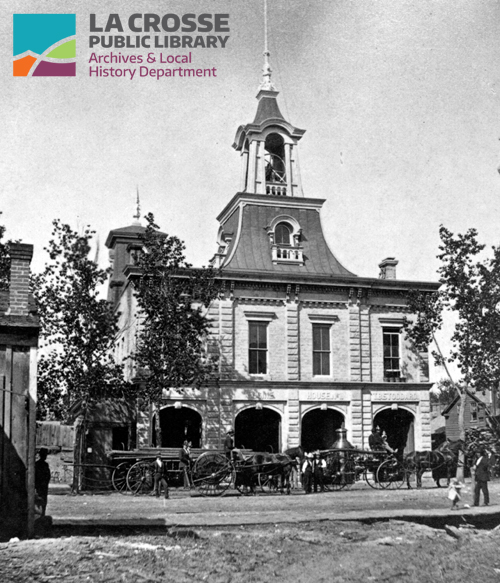
The First City Hall and Fire Station has the mansard roof, dormer windows, and brackets under the eaves typical of the Second Empire style.
There were balconies at each of the windows on the four sides of the roof. For several years these balconies were open to the public and were reknowned for the view of the city. Above the roof was a small bell tower with corner columns supporting a smaller version of the main roof below.
The city tried to save money with a two-for-one design, a fire station on the ground floor and city offices on the second floor. The city got what it asked for in an elegant design, but the idea was not thought out very well. Odor from the horses used to pull the fire equipment was an ongoing nuisance. Noise from the firemen grooming the horses, feeding and washing them, went on every day. Office work was interrupted when the bells rang and the engines raced off to the fire. The workers complained, the firemen complained, but the city didn’t build a new city hall until 1891; designed in the Romanesque Revival style by Stoltze & Schick. The old building was sold and became stores with “modern” brick covering the original rusticated stone. It gradually deteriorated and was demolished in order to extend a bank parking lot.
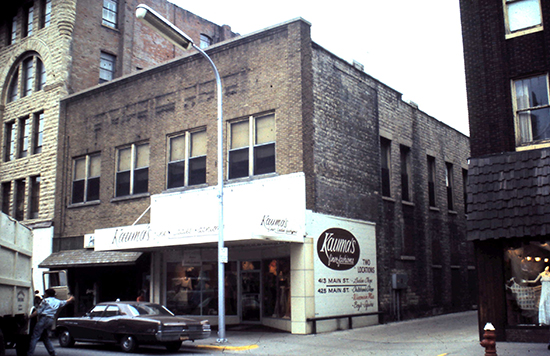
The building, a few years before being razed, is unrecognizable as a Second Empire style. 1980 photo by author.
Commercial Buildings
Mons Anderson Building, NW corner of 2nd & Main, 1870
The store for Mons Anderson was begun in 1856 and after two additions was completed in 1870. The Main Street front had columns, arches and pediments that make it the most accurate use of the Second Empire style. Although this newspaper reporter didn’t know much about architecture, he was impressed by the new store:
Built in Renaissance style of architecture externally, with store fronts of iron, filled with plate glass. The walls and dressings are of cut stone of the celebrated Magnesian limestone, from the quarries near town, which is of a beautifully bright cream tint, and very durable.
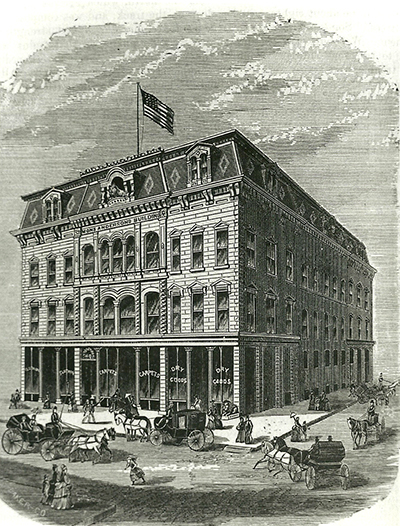
An engraving of the Mons Anderson. The building was originally home to Anderson’s retail and wholesale business.

A photograph shows the mansard roof and decorative columns. The building was razed as part of the Harborview Project in 1974.
Second Empire Houses
Bussell-Solberg House, 905 Main Street, 1870
The brick Bussell-Solberg house was the first use of the style in a domestic building. Bussell’s house at Main and 9th was the most prestigious location at the time of construction. One-story bays with balustraded porches on their tops flank the entrance and one bay on the west side also has a porch. Brackets, popular in the Italianate style that was more common at the time, are under the eaves. In the front of the second floor, a series of concentric arches covers the double doors leading out onto the porch. Porches on the west side still have great examples of the Italianate style.
Like most of William Nichols designs, he has mixed elements of different styles, but maintains a harmony of parts.The distinctive mansard roof and dormer windows with shallow hoods that are recessed into the concave roof have thus far escaped the architectural vandalism.
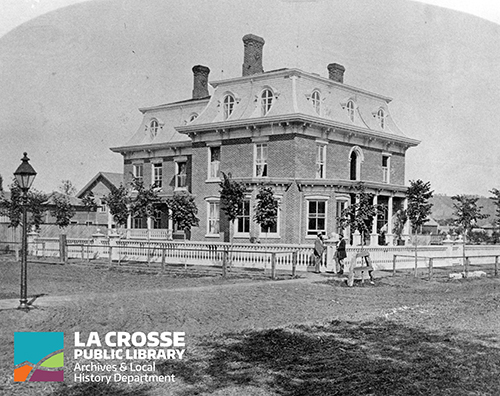
This photo shows the home with the original brick exterior. Mr. Bussell stands at the corner, on the left.

The home was stuccoed sometime in the early twentieth century in an effort to modernize it.
Bishop’s House, 608 S. 11th St., 1877
The former Bishop’s residence (now Siena Hall) has a very low mansard roof with decorative slates, otherwise the building uses Italianate round stone arches over the windows in the lower floors, which contrast nicely with the brick walls. The low height of the mansard roof makes the attic area unuseable for habitation, which contradicts the reason for the shape of the mansard roof. This denial of the function of the mansard roof indicates that it has become just another design element in the architect’s tool box.

The Bishop’s house in 1881. The Second Empire style is represented in the mansard roof, though not functional as the original intent.

A more recent photo displays decorative shingles added to the roof, which compliment the Second Empire style. 2012 photo by author.
McCain House, 802 Caledonia St., 1885
John McCain, who worked as an engineer and then a policeman, paid the taxes on the empty lot at 802 Caledonia St. beginning in 1881 and in 1885 the value went from $75 to $1350, a clear indication of this house being built. The Second Empire style was actually “out of fashion” in La Crosse by this time.
The McCain house shows the mansard roof on a tiny house, with no other Second Empire features. The dormer windows are not hooded but have a traditional gable roof. The house is a typical three-bay box with the entrance at the side, and a kitchen wing on the left side, but of course the outstanding feature is the tall mansard roof, unique in this area of town.
I suspect John wanted the extra space in the attic and was not overly concerned about popular architectural styles. The dormer windows were once nicely detailed in contrast to the simple stone arched window heads of the ground floor. Notice how the header above the front door matches the curve of the window heads. The entrance porch has square columns that are larger and thus more important than the columns on the kitchen porch.
A few paired brackets, simple in design, are under the eaves. McCain could only afford a small house, but he got the most distinctive house on the north side.
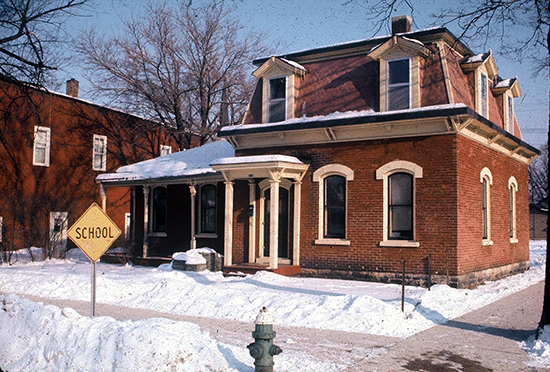
The house’s appearance remained mostly unchanged from the 1880s as seen here. 1975 photo by author.
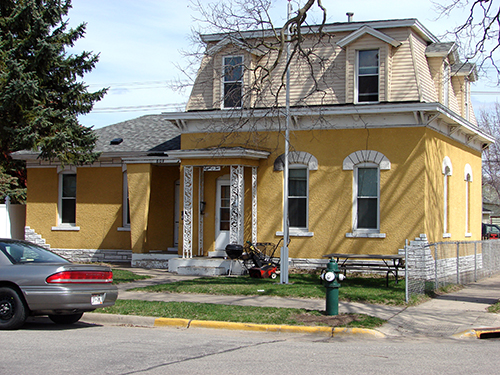
This more recent photo shows the changes made over the years including stucco and vinyl siding added to the mansard roof. 2011 photo by author.
Second Empire Restoration
Esperson-Pettibone House, 143-149 S. 8th St., 1876
Henry S. Esperson came to La Crosse in 1858. He had a jewelry store in 1861, but that would have been a tough business in such a small new town. He was listed in the first city directory of 1866 as a land agent and in 1869 he was building a new brick commercial block on Third Street, probably the Esperson House at the north west corner of Pearl and Third streets.
In 1876, Esperson built a brick house at a cost of $9,000 that the newspaper says was 18 x 25, 19 x 37 and 28 x 28, referring to the front section, middle section and rear part.
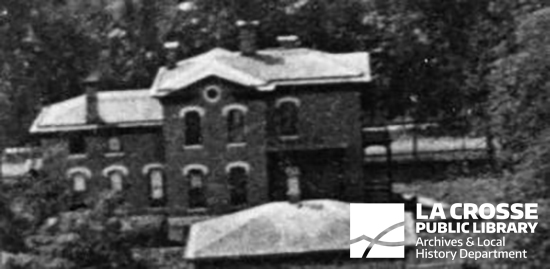
This detail photo from a larger image by the Winona photographers Elmer & Tenney shows Esperson’s house, a wonderful cross gable Italianate with white limestone window heads a one story porch at the entrance and a secondary entrance to one side.
In 1885, he sold his house to A.W. Pettibone, who had it remodeled into a Second Empire Style house in 1898 and lived here until his death in 1915. I have no idea why the Second Empire style would be used in his remodeling, it was long out of fashion by then.
While the new roof on the Italianate house was Second Empire, the spindle work porch was from the Queen Anne style. Second Empire porches used more robust verticals with arches or railings in stone but this was La Crosse and wood was much less expensive and more readily available to builders. The thick shapes of the lathe turned posts are in strong contrast to the delicate spindles and balusters of the railing. There was cresting, probably cast-iron, above the bay window on the right and on the top of the porch above the formal entrance.
The porch had two sets of steps and two entrances. The entrance to the left in the old photo has a low-pitched pediment above it to signify its importance. This was the formal entrance that led to the stair hall and parlor. The roof line and wall above this entrance is stepped forward slightly on the second level above the entrance, creating a more elaborate, almost tower-like shape to show you where to enter the house. The entrance on the right was the family entrance and led to a door in the offset bay. This entrance has no pediment, nor any special decorations on the roof line.

The addition of the mansard roof can be seen here, as well as the Queen Anne porch.
Like many large houses, this one was turned into apartments and its condition declined over the years.

The mansard roof remains, but the Queen Anne porch is gone in this photo. Enclosures were added on the former porch areas.
The recent restoration of this house and its reuse as apartments marks another significant win for the city and preservationists. A declining property was rejuvinated and will pay more in taxes. Visually, the neighborhood is enhanced.

The restoration of this house included opening up the enclosures and bringing back the Queen Anne style porch. Portions of the mansard roof was also rebuilt.
Odd Fellows Building, 119 S. 4th St.
Looking at the downtown, we also see restorative changes. As recently as 1964, the Odd Fellows Building had a mansard roof, but it was gone when I came to La Crosse in 1969.

The mansard roof of the Odd Fellows building is visible on the right just above the street light.

The mansard roof had been removed and filled in with brick. 2013 photo by author.
It has recently been restored through funding provided through the façade restoration program, and was designed by architect Marcus Zettler. The building is complete once more -- a success for architectural preservation.
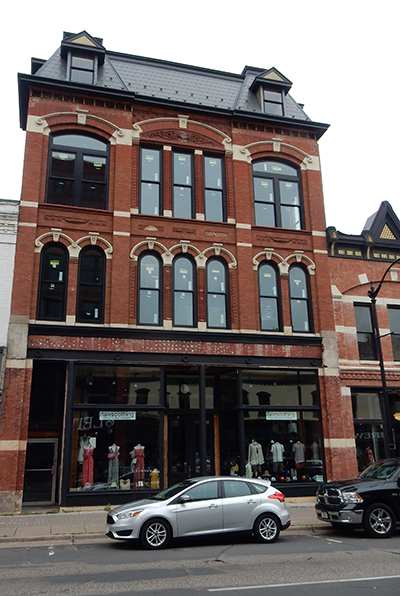
The mansard roof is back, along with windows that return the building to its Second Empire style.
Next week, we will learn about one of the most recognizable styles of the Victorian era: the Queen Anne.
Other entries in this series
Architectural Styles and Revivals
Architectural Styles and Revivals: The Greek and Roman Revivals
Architectural Styles and Revivals: The Gothic Revival
Architectural Styles and Revivals: The Exotic Revival
Architectural Styles and Revivals: The Italianate Style
Architectural Styles and Revivals: The Queen Anne Style
Architectural Styles and Revivals: The Colonial Revival
Architectural Styles and Revivals: Romanesque Revival Public Buildings
Architectural Styles and Revivals: Romanesque Revival Commercial Buildings
Architectural Styles and Revivals: Romanesque Revival Homes
Architectural Styles and Revivals: Religious Romanesque
